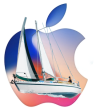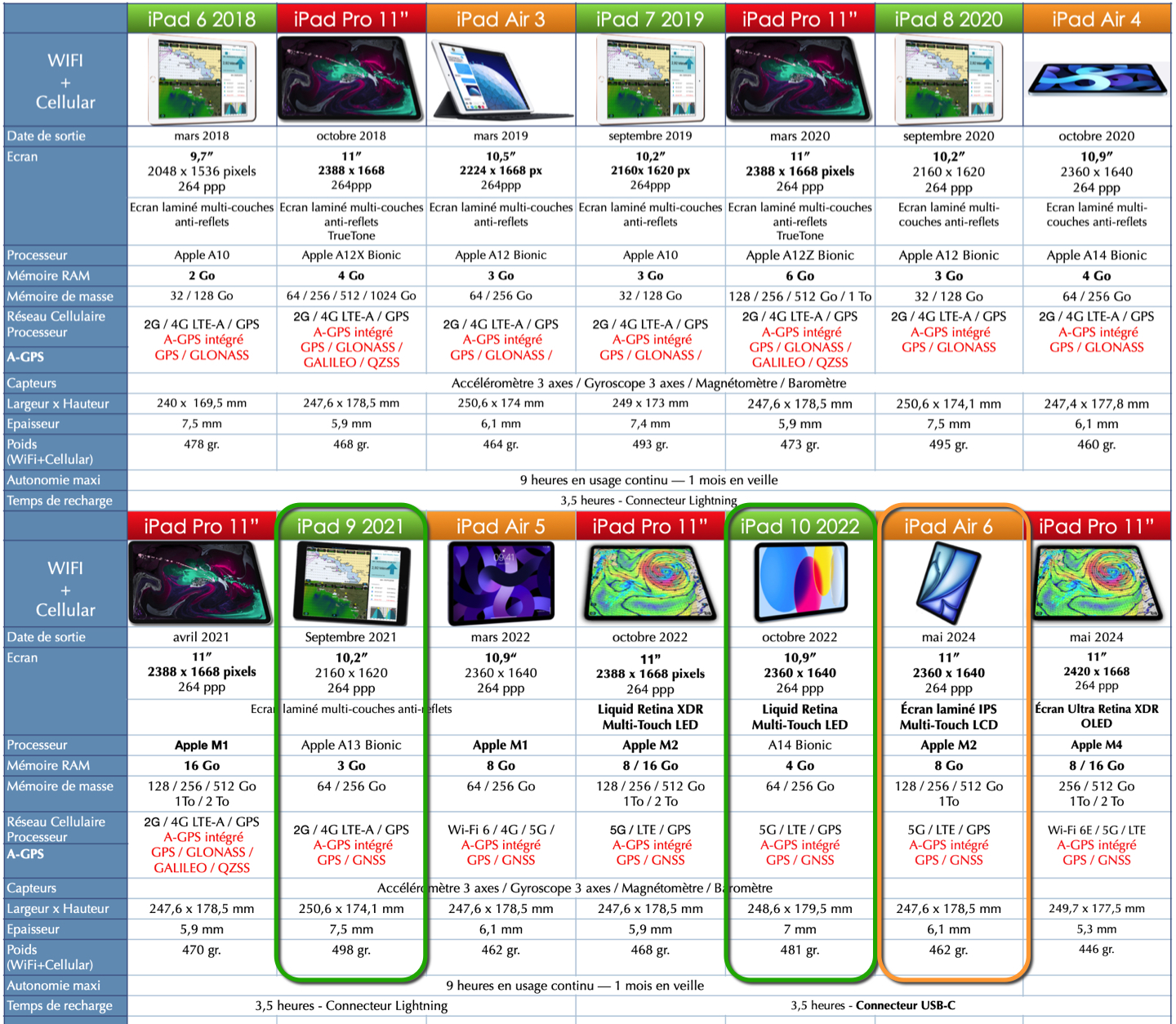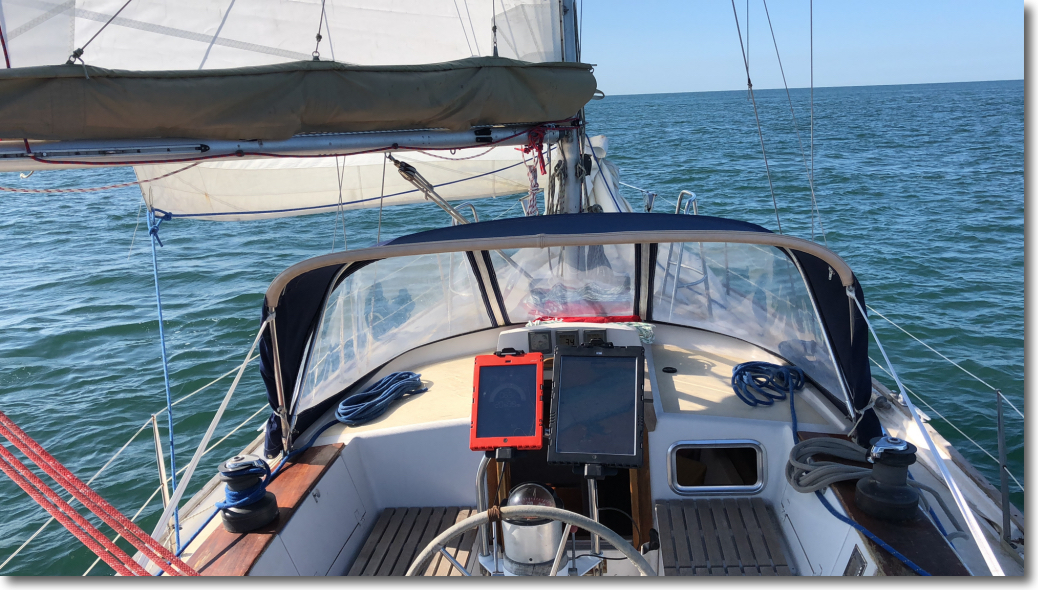Many of you ask me about choosing an iPad for boating use. Unfortunately having no time to respond to every request a post is required. Each year it is advisable to review this question, and sometimes more often.
With the presentation of the last two iPads this 18 October 2022, the chipset Apple Silicon M2 comes up on models iPad Pro 11″ up to 12,9″, with 8 or 16 GB of RAM of RAM memory (depending on storage capacity). The new iPad 10 " low cost" receives the A14 Bionic chip from the iPad Air 4 with a screen extended to 10.9″. The great novelty of all these devices is the appearance of the USB-C connector imposed by the European Union, and the supply of the USB-C charger and cable.
Criteria to choose an iPad
There are several, which does not only depend on marine use, but also the home use of your tablet.
- Model : I have mentioned it several times in my website (²) and several entries (³), model Wi-Fi + Cellular is imperative to be provided with GPS. With a single Wi-Fi model, you must add, either GPS Bluetooth, either multiplexer to fetch NMEA data from the on-board GPS, which limits the use of the tablet.
- Storage memory : from 32 up to 512 GB depending on the version and up 2 TB for the latest "Pro", the choice is wide. For a strict navigation use , with applications using cartography vector, 64 Go could be enough to go around the world. But if you use raster charts, larger than the vector charting for equivalent area , therefore 128 Go are unmissable. Beware though : if you store your travel pics and videos, if you add music and movies, 256 GB or more will not be too much.
- The size and screen resolution : iPad (10-11 inches) or iPad Mini (± 8 inches), I would say that the choice depends mainly on the distance between mariner and screen. So actually vessel size. I will take an iPad Mini on a 18-25 feet, but beyond the distance between the helmsman and the location of the iPad justify maybe a screen 10 inches screen for easier reading. The screens Liquid Retina high resolution became widespread and provide excellent definition on raster charting and satellite imagery. Since 2016 devices benefit from a laminated screen antireflection multicoated and a LED backlight, which allows fairly correct daylight reading, especially with a sun visor added to the case. Models 13″, heavy and expensive, respond more to use on the chart table than to mobile use on board.
Different versions
There are now countless versions : 21 total models since 2010 in 10/11″, 6 in 12.9″, up to 6 Mini 8″.
• History : from iPad 1 to iPad Air 2 (2010-2015)
Initial iPad1, historical tablets some of which have traveled thousands of miles for several years, are no longer supported by Apple, just like iPad 2 up to 4 up to iPad Air 1st generation. This means no more possible updates to iOS and the eventual obsolescence of applications that developers cannot keep backwards-compatible indefinitely. The majority of applications today only work on iOS/iPadOS 10 and next.
The first iPad Mini in october 2012 had the same characteristics as the iPad 2. It was a great tablet, with a screen that has nothing to envy to its big sister, autonomy for long days of navigation and fast power charging. Replaced by the successive versions Retina display, an iPad Mini 6 came up in September 2021 with a screen 8,3″ Liquid Retina and built-in with A15 Bionic processor.
• Today (2016-2022)
March 2016, the arrival of an iPad Pro 9.7″ with a still more powerful processor and a memory up to 256 GB of RAM, but more expensive than iPad Air 2, do not then represented a decisive advantage for navigation use. The following years, Apple has expanded the size of the iPad Pro screen to 10,5″ then recently 11″. But these high-priced devices have been accompanied each year by several iPad 9,7” "low-cost", to attract tight budget. In 2019 The arrival of the’iPad Air 3 10,5″ at a very attractive price despite its A12 Bionic processor and 3 GB RAM, positioned it between the iPad 9.7″ 2018 and iPad Pro 11″. It replaced my own iPad Air 2 in 2020. Today, It is prudent to choose a used device that does not exceed 4 years of service, or an entry-level model in a new model.
How easily one gets lost, in a nutshell, Apple now offers three lines of iPad :
- iPad = "Low cost " (generally based on a previous box with one or two improvements) first pricing.
- iPad Air = thin and light midrange with good quality features. Still attractive prices.
- iPad Pro = the brand's high-end technology. The most expensive of course.
In November 2015 has launched the large iPad Pro with a 12.9 screen″, optionally provided with a keyboard, supposed to come competing Microsoft Surface devices in the professional market. For pleasure, its size and weight make it ideal for the chart table, Despite the availability of a waterproof case and supports allowing to use it outside. This model has been the subject of five successive versions. The last one is equipped with the processor Apple M2, from 8 or 16 GB of RAM RAM according to storage capacity, from 128 GB of RAM until 2 TB storage.
My advice
• Second hand or Apple refurbished
- iPad 8 (sept. 2020) " "low-cost" with 128 GB of RAM storage, or iPad 9 with 256 GB of RAM to start at a low price, would be my best second-hand choice. Tablets with excellent performance good enough for navigation, if you are looking for the cheapest but not the oldest.
- iPad Air 3 (March 2019) was my best choice used to sail, but now too old to be advised, and’iPad Air 4 much too expensive at its release remains expensive second-hand.
• Buy new
- iPad 10 10,9″ (oct. 2022), it's the latest iPad" low cost". With its A14 Bionic processor, its 4 GB RAM, in 256 GB of storage, this is my best new choice for navigation. In addition, its USB-C connector becomes universal.
- iPad Air 5 10,9″ (2022), a powerful device perfectly suited to navigation, but still expensive in WiFi + Cellular with 256 GB of RAM (200 € more than iPad 10).
- iPad Pro 11″ and 12.9″ 6th generation (oct. 2022), they are overpowered and very expensive. To avoid for navigation, except to replace a chartplotter at the chart table.
Warning : the last system iPadOS 17.x is only compatible with devices with A10 chips and above (See list). Older iPads will no longer be able to evolve. Reminder, once the devices cross the fateful seven-year mark, they are generally considered obsolete by Apple.
Meet you when the next models come up.
–––
(²) Apple devices
(³) iPad , GPS and subscription to the cellular network This post dating from 2011 is unfortunately still relevant !
–––





Hello,
I regularly use an Ipad Air 3 from 2020 with waterproof aiShell cover with the Navionics Boating app. The set placed on a caliper in front of the wheel bar is very ergonomic and the sun visor is effective.
Unfortunately the GPS signal freezes intermittently and more and more frequently.. Not all OS and app updates resolve the issue. On an Apple support forum I see that many users have identical problems with Ipad models of 2020. Would there be a problem with the GPS of this version?
Do you want to give your opinion because I read that you are also a user of this template.
Hello, I actually use an iPad Air 3 Bought second-hand at Rebuy.fr in December 2020. I have not experienced any problems positioning at sea with the built-in GPS. There may have been a bad manufacturing run. You should contact an Apple Center, if this fault has been referenced, You could benefit from a free repair.
Hello and thank you for these very interesting articles,
On iPads with GPS + Cellular, is it possible to disable these chips to save battery (I have a wifi/NMEA gateway, so the GPS of the tablet would only be a backup mode).
We can't, strictly speaking, disable GPS reception. The only thing you need to do is remove the use of location service for apps that don't need it. For example, with Weather4D and the location service set to "always", if you are using NMEA GPS, this does not cut off the use of GPS in order to maintain trace recording and alarms when the app is in standby mode (functions remaining active in the background). On the other hand, by disabling the "Navigation" mode (when we only do simulations) Weather4D disables the use of GPS to save battery.
Hello,
From all this I remember that maybe MacENC will come back. And suddenly I could continue to use my Mac Mini and even my new one ??
Thank you Francis
Quite Francois. Do they still have to find a map for Europe. Navionics charts ? NV Charts ? It's still under negotiation.
You recommend aiShell 10 protection″5 the link on the Itabnav site offers it to 239 €. What a difference in quality with the iPad case 10.2 which appears to have the same IP69K characteristics of Mooncase at 95 €
Thank you
Because the aiShell is the most robust shell on the market, widely proven since 10 years by circum navigators and runners, and that it has serious support accessories. Germanic quasi-military manufacture. When using a tablet at 700-800 € and more, better not to skimp on protection.
Can the arrival of the new MAC ARMs mean that we will be able to run iOS software, since MacOS navigation software is no longer developed ?
Indeed it should not be long. The return of MacENC is also imminent.
Nice to take the time to present these clear and concise explanations. My iPad AIr 2 that you advised at the time still works as well as the first day. It is in iOS 14.
Mine too
Always crisp and clear
Thank you here is a clear and concise answer I like.